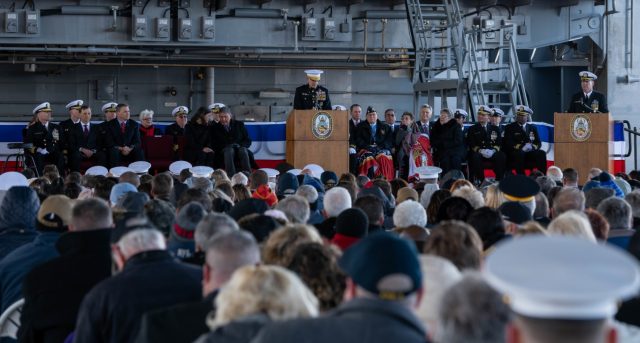
The US Navy commissioned the expeditionary sea base ship USS Hershel “Woody” Williams (ESB 4) in a ceremony in downtown Norfolk, on May 6.
The ship is named for Marine Corps veteran, Hershel “Woody” Williams, known for his heroism during the Battle of Iwo Jima in World War II. On Oct. 5, 1945, President Harry S. Truman presented Williams with the Medal of Honor during a group ceremony at the White House.
Williams attended the ceremony, passing the long glass (telescope) to the officer of the deck as part of the US Navy commissioning ceremony procedure.
“This is an ESB, an expeditionary sea base,” said Gen. David H. Berger, commandant of the Marine Corps, describing the ship to the crowd. “It is a floating, moving island. Two things stand out: versatility and affordability. This ship is purpose built to be versatile and flexible, modular. We need more ships like this.”
In commissioning ESB 4, the nearly 1,200 guests saw the ship converted from a USNS to a USS asset in order for the warship to meet the challenges and requirements of serving in and around the US Africa Command, US European Command and the 5th and 6th Fleet areas of operation. Under the law of armed conflict, missions such as special operations staging and mine-countermeasure operations must be conducted by a warship.
Hershel “Woody” Williams follows USS Lewis B. Puller (ESB 3), which is forward deployed to the 5th Fleet area of operations. The 784ft.-long vessel features a 52,000 square-foot flight deck, fuel and equipment storage, magazines, repair and mission-planning spaces. Its features include a four spot flight deck, a mission deck and hangar, work and living spaces for a couple hundred staff and embarked personnel.
Williams is the last living Medal of Honor recipient from the Battle of Iwo Jima. He helped set the ship’s first watch, but it was his two daughters who symbolically brought the ship to life – and sent the sailors running aboard – after urging them to “Man the ship and bring her to life!”


























